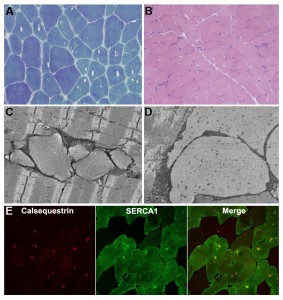Chronic elevation of serum creatine kinase (CK) is a common manifestation of neuromuscular disorders and may precede disease clinical expression, or remain asymptomatic. In 3 Italian families having high CK, mild myopathy, and calsequestrin-positive inclusions in muscle fibers, exome and Sanger sequencing and linkage analysis revealed a founder mutation in the CASQ1 gene. Immunocytochemistry, electron microscopy, biochemistry, and transfected cell line investigations showed a tendency of the mutated calsequestrin to form aggregates. CASQ1 mutations may go undiagnosed if a muscle biopsy is not taken, and the condition could be more frequent than supposed in patients with familial hyperCKemia. (By Dr. Marina Mora, http://jmg.bmj.com/content/early/2015/07/01/jmedgenet-2014-102882 )
(Muscle histopathology. in CASQ1 mutated patients (A) Gomori trichrome and (B) H&E staining show several sarcoplasmic vacuoles, that, by electron microscopy (C,D) appear as large, often membrane-limited inclusions of variable size, shape and electron density, forming aggregations often lobular; (E) immunohistochemistry shows positivity of vacuoles to calsequestrin and SERCA1.)
